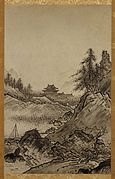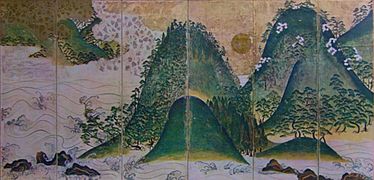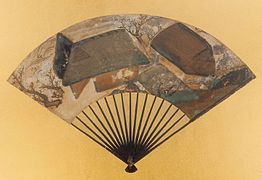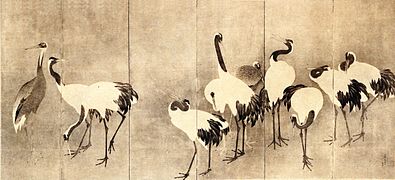Exhibition of Ancient Japanese Art 1939

The exhibition of Old Japanese Art ( Japanese 日本 古 美術展 覧 会 , Nihon kobijutsu tenrankai ) opened on Tuesday, February 28, 1939 , lasted until Friday, March 31, 1939 and took place in the Staatliche Museen Berlin . On this occasion, Japan showed almost 30 national treasures in Berlin , i.e. objects of art that are actually not allowed to be taken out of the country.
The exhibition is documented in the generally accessible catalog "Exhibition of Old Japanese Art" and in the large-format "Memory Catalog of the Exhibition of Old Japanese Art Berlin 1939" in a small edition, which contains the texts in Japanese.
prehistory
As early as 1910, the later general director Otto Kümmel had thought of bringing the exhibition of Japanese art in London to Berlin afterwards, but this did not succeed. Then came the First World War, in which Japan, which was already linked to England, sided with the Western powers. In 1931 there was an exhibition of Japanese painting , and in 1937 Kümmel began a new attempt, together with von Dirksen, then ambassador to Japan, which was then granted success.
The development of German research on Japanese art history was examined with particular attention to the historical boundaries of the epoch. By comparing the epoch boundaries, it was recognized that the exhibition of ancient Japanese art in 1939 divided the eras differently than its predecessors, the Paris World Exhibition in 1900 and the Japanese and East Asian art exhibitions of 1909 and 1912.
The division of epochs from 1939 has something in common with the work “History of Japanese Art”, which was written in 1964 by the Japanese art historian Honshin Kuroda. The same epoch boundaries also apply in the later works of Japanese art history by Takeshi Kuno in 1980 and by Kazuo Mochimaru in 1986. With regard to these precise and then new epoch boundaries, it can be said that the exhibition of ancient Japanese art in 1939 was the great advance in Japanese art history in Germany .
organization
- Patrons
- German patron: Field Marshal General Hermann Göring , Prussian Prime Minister
- Japanese patron: Baron Hiranuma Kiichirō , Imperial Japanese Prime Minister
- Honorary Committee
- Reich Minister for Foreign Affairs Joachim von Ribbentrop
- Head of the special delegation of the Imperial Japanese Government for the exhibition: Marquis Inoue Saburō (1887-1959)
- Japanese General Committee:
- President: Marquis Ōkubo Yasutoshi , member of the House of Lords, President of the German-Japanese Cultural Institute in Tokyo, 60 members,
- Japanese Working Committee
- President Nagai Matsuzō ( 永 井 松 三 ; 1877–1957), 10 members.
- German working committee
- Herbert von Dirksen , German ambassador in London, first chairman of the Society for East Asian Art. With Dirksen 18 members, including Kümmel, Wilhelm Gundert , Martin Ramming , Leopold Reidemeister , Fritz Rumpf .
The exhibition
The exhibition opened on Tuesday, February 28th, in the presence of Hitler , Dietrich , Frick , Himmler , Meißner , Ribbentrop, Rosenberg , Rust and others in the Pergamon Museum , then also known as the “Deutsches Museum”.
Otto Kümmel read the welcoming speech in place of the sick von Dirksen. On the Japanese side, Ambassador Ōshima expressed to his friends that old Japanese works of art can be shown in Germany. The head of the Japanese cultural mission, Marquis Inoue, also spoke.
The rooms of the German Museum selected for the art exhibition had a wooden rod network as wall covering, which gave the pictures a restrained background. In order to increase their effect, the pictures themselves were mostly embedded in the walls and protected by glass, unless they were shown in showcases.
28 national treasures (⦿), 57 important cultural assets (◎), 37 other works, a total of 126 works were exhibited in Berlin .
Lenders were: the Imperial House, the Imperial Museum Tōkyō, the Ministry of Culture, the Art Academy Tōkyō, the City Museum Kyoto, 24 temples and shrines, 30 private individuals. The works are structured in the catalog as indicated below, with those declared as cultural assets with the owners at the time in brackets.
The main exhibited works
Buddhist sculptures
- Kannon ( Hōryū-ji ; ⦿)
- Kannon ( Kakurin-ji ; ⦿)
- Shaka ( Murō-ji ; ⦿)
- Eleven-faced Kannon ( Shin-Yakushi-ji ; ⦿)
- Kichijō-ten ( Daigo-ji ; ⦿)
- Nyoirin Kannon ( Kanshin-ji ; ⦿)
- Fudō-myōō ( Yokoyama Taikan ; ⦿)
- Bishamon-ten (Hashimoto Kansetsu; ⦿)
- Kongō Rikishi and Taishaku-ten ( Myōhō-in ; ⦿)
- Kōen: Monju and four companions (Nakano Chūtarō; ⦿)
- Priest portrait ( Rokuharamitsu-ji ; ⦿)
- Portrait of a high official (Hara, Sue; ⦿)
- Daitoku Myōō ( Daikaku-ji ; ◎)
- Eleven-faced Kannon in the altar shrine (Inoue, Saburō; ◎)
- Protective deity of Yakushi (Masuda, Tarō; ◎)
- Jizō (Niitsu, Tsunekichi; ◎)
- Genki: Shaka (Noda, Kichibei; ◎)
Masks
- Four Bugaku masks (Itsukushima shrine; ⦿)
- Four gigaku masks (Hara, Tomitatarō; ◎)
Nō robes
Buddhist painting
- Emma-ten ( Kanchi-in ; ⦿), Kyōto
- Bishamon-ten ( Uesugi-jinja ; ⦿)
- Fudō-Myōō ( Kuri-ji ; ⦿)
- The mandala of the two worlds (Uesugi-jinja; ⦿)
- Amida and 25 Bodhisatva ( An'yō-ji , Fukui Prefecture ; ⦿)
- Shaka (Masuda, Tarō; ◎)
- Kokuzō with Myōjō and Bishimon (Mitsui, Takaharu; ◎)
- Fugen Emmyō ( Kanchi-in ; ◎)
- Three dairikiku (fugue-in; ◎)
- Pilgrimage of the Zenzai Dōj ( Tōdai-ji ; ◎)
- Nyoirin Kannpn (Dan, Inō; ◎)
- The life of the Buddha (Dan, Inō; ◎)
- Godaison (Kokawa-dera; ◎)
- Butsugen Mandala ( Tō-ji ; ◎)
- Sonshō Nandala (Kanchi-in; ◎)
- Monju with eight companions (Inoue, Saburō; ◎)
- Portrait of a court lord (Katō, Masaharu; ◎)
- The four world guardians (Masuda, Tarō; ◎)
- Death of the Buddha (Mitsui, Takaharu; ◎)
- Monju (Moriya, Kōzō; ◎)
- Aizen Myōō (Nezu, Kaiichirō; ◎)
- Pilgrimage of the Zenzai Doji (Nezu, Kaiichirō; ◎)
- Mincho: Ten rakan (Nezu, Kaiichirō; ◎)
- Kasuga Madala (Yuasa, Shichizaemon; ◎)
Yamato-e and Bunjin-ga
- Life of the Hōnen (Dan, Inō; ⦿)
- Excursion of the emperor to Ono ( Tokyo Art Academy ; ⦿)
- Fairy tales of Haseo and the demon (Hosokawa, Moritatsu; ⦿)
- History of the Shogunzuka ( Kōzan-ji ; ⦿)
- Keinin and Shojūmaro (Masuda, Tarō; ◎)
- Purgatory (hara, yasu; ◎)
- From the Eiga Monogatari (Iwasaki, Koyata; ◎)
- Sumiyoshi Monogatari (Iwasaki, Koyata; ◎)
- Festival of poetry, copy after Fujiwara no Nobuzane (Kujō, Michihide; ◎)
- Life of Ippen (Maeda, Toshinari; ◎)
- Fairy tale of the demon Zegaibō (Sumitomo, Kichizaemon; ◎)
Ink painting
- Kaihō Yūshō : peonies ( Myoshin-ji ; ⦿)
- Hasegawa Tōhaku : monkeys and bamboo grove ( Shōkoku-ji ; ⦿)
- Unkoku Tōgan : landscape, 2 screens (Fujise, Shinichirō; ⦿)
- Mokuan : Hotei (Katō, Masaharu; ◎)
- Sesson : waves and beach (Mutō, Kinta; ◎)
- Sesson; Sailboats in a storm (Nomura, Tokushichi; ◎)
- Shūbun ?: Landscape (Sumitomo, Kichizaemon; ◎)
Display screens from different schools
- Landscape with the sun and moon ( Kongō-ji ; ◎)
- Son-i on the way to the Imperial Palace (Mutō, Kinta; ◎)
- Kyōto and surroundings (Sanjō, Kimiteru; ◎)
- Yamaguchi Sekkei: screen pair with maple (Daigo-ji; ◎)
Kanō School
- Kanō Tan'yū : pines in the four seasons, pair of screens ( Daitoku-ji ; ◎)
- Kanō Naonobu : Eight Views of Xiāoxiāng, pair of screens ( Tokyo National Museum )
- Kanō Tsunenobu : Three Chinese Sages
Koetsu School and Bunjinga
- Tawaraya Sōtatsu : Bugaku dance ( Sambō-in ; ⦿)
- Tawaraya Sōtatsu: Two adjustable screens (Sambō-in; ⦿)
- Tawara Sotatsu: priest Saigyo (Watanabe, Akira; ◎)
- Ogata Kōrin : The 36 poets, screen pair (Inō, Dan; ◎)
- Ogata Kōrin: White plums, two screens (Kosaka Junzō; ◎)
- Ogata Kōrin: Murasaki Shikibu (Magoshi, Kyōichi; ◎)
- Ogata Kōrin: God of wind and thunder, pair of screens (Tokugawa, Muneyoshi; ◎)
- Ogata Kōrin: Animal Studies (Watanabe, Zenjirō; ◎)
- Sakai Hōitsu : autumn by the stream, autumn in the wind, pair of adjustable screens (Tokugawa, Muneyoshi; ◎)
- Watanabe Kazan : Temple walk to Meguro (Nagao, Kinya; ◎)
Maruyama Shijō School
- Maruyama Ōkyo , Komai Genki: Three Beauties (Kōnoike, Zenemon; ◎)
- Maruyama Ōkyo: Nature studies (Nishimura, Sōzaemon; ◎)
- Maruyama Ōkyo: Festival of the Four Seasons (Tokugawa Foundation, Nagoya; ◎)
Ukiyo-e
- Dancers (Kyōto City Museum; ◎)
- Kitagawa Utamaro : woman changing clothes (Hara Sue; ◎)
- Katsushika Hokusai : woman in the snow (Kosaka Junzō; ◎)
- Katsukawa Shunshō : Ten monthly pictures (Nakano, Chutarō; ◎)
- Miyagawa Chōshun : courtesan (Seino, Chōichirō; ◎)
Image selection
Sesshu : Winter
Reaction in the press
At the end of 1938, German newspapers began reporting over a hundred times about the upcoming exhibition. On the day it opened, February 28, 1939, fifty newspaper reports appeared. By the end of March 1939, the end of the exhibition, there had been a total of about three hundred and fifty times more or less detailed positive reports.
Remarks
- ↑ The classification of the exhibited cultural assets has changed significantly since then.
- ↑ Most of the treasures from private collections have now become the property of museums.
- ↑ Painted on the back by Kōrin's god of wind and thunder.
- ↑ Back then, as in autumn, still without distinction. Today national treasure.
- ↑ Together with other compartments mounted on a pair of adjustable screens, then registered as a national treasure.
Individual evidence
- ↑ Yasumatsu, Miyuki: Report Beuppu Univ.
- ↑ Tagesspiegel from November 18, 2013
- ↑ a b c Walravens, Hartmut (Ed.): Press documentation on the old Japan exhibition in 1939 in Berlin. Part 1 to 3 . Berlin State Library, 2010.
Used literature
- Japanese Committee for the Berlin Exhibition of Ancient Japanese Art (Hrsg.): Memorial catalog of the Exhibition of Ancient Japanese Art Berlin 1939.
- Staatliche Museen, Berlin (Ed.): Exhibition of old Japanese art . Verlag für Kunstwissenschaft Berlin. Berlin 1939.












